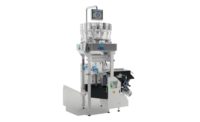
Most people today might associate the phrase “Life begins at 40” with the 1980 John Lennon song or, perhaps, the music video from Dave and the Dynamos. Going further back, a few 40-plus-year-olds might remember the 1935 movie by the same name starring Will Rogers. Yet the man who coined the phrase - and literally wrote a book on the topic - Walter B. Pitkin, rarely comes up in discussion.
Pitkin’s popular self-help book, published during the tail-end of the Great Depression in 1932 as an antidote to despair and gloom, probably best reflects the mood prevalent at the International Sweets & Biscuits Fair held Jan. 31-Feb. 3 in Cologne, Germany.
Just as Pitkin’s positivist view of middle age helped thousands of Americans grabbling with the Great Depression, so, too, did ISM light a spark for hundreds of exhibitors and thousands of attendees.
Ironically, the first ISM slogan - “The right trade fair at the right time,” which goes back to 1971 - seemed particularly apropos 40 years later. Having survived the 2008/2009 global recession, confectionery manufacturers displayed their traditional resilience amidst a particularly far-reaching downturn.
The nearly 1,500 exhibitors reaffirmed the notion that the industry had managed to stave off the worst brought on by the economic slowdown. They all stood poised to rev up their sweetly tuned engines and shift back into normal operating speed.
And what did those 32,000 buyers from more than 140 countries seen at the show?
Although it’s impossible to relate all the sweet temptations and salty offerings scattered throughout the ISM’s five halls, encompassing 110,000 sq. meters, the following cross-section of products highlights a critical current, encompassing a broad range of existing and evolving sub-trends. (Visitnewproducts.ism-cologne.defor a complete rundown.)
It’s clear that buyers and manufacturers are coming to terms with consumers looking for and demanding greater value. This value proposition, which may have simply meant less cost in the past, now embraces several other parameters, such as better ingredients, more convenient packaging, more appropriate sizes, specific sourcing, customized processing, healthier formulations … well, the list goes on.
Thus, product innovation takes on even greater importance as manufacturers seek to capture an ever-calculating consumer.
After the successful debut of the New Product Showcase at ISM in 2009, show organizers this year invited journalists to select the top three innovations from 93 items displayed at the Boulevard.
After the tabulating was done, industry scribes selected their top three favorites:
•Sushi in the Cityfrom Rovacos SA
• Reduced-sugar chocolate with stevia from Villars Maître Chocolatier SA
•Trolli Cheesecake gummi from Mederer GmbH
Although it would be presumptuous to base future confectionery trends on selections by journalists - after all, how close are their palates to the mainstream? - the winners certainly address many of the sub-trends cited in the value proposition: a visual and sensory delight; a natural, healthier chocolate alternative; and a fun-filled, flavored sweet treat.

The Swiss company Villars Maître Chocolatier SA also impressed journalists with its reduced-sugar dark chocolate bar. Using a natural sweetener obtained from the leaves of the stevia plant, the Swiss chocolate expert experimented for more than a year-and-a-half with rebaudioside A, the stevia extract, before settling on the final formulation.
Finally, there’s theTrolli Cheesecake gummi from Mederer GmbH. The three-layer gummi perfectly captures the cheesecake flavor note as well as appearance. What’s really impressive is that once the gummi is packaged, the “graham crust” layer actually develops a more textural crunch after two weeks.
Another example of a company that addressed the many variants involved in providing consumers a tempting value proposition is Cologne-based Stollwerck, one of Barry Callebaut’s few remaining consumer operations.
Conscious of parental scrutiny regarding sweets for children, the company will launch the first tooth-friendly chocolate for children this July with itsAlpia MountiesChoco Bears. Formulated with isomaltulose, a naturally derived sugar beet extract that has been proven to be healthy for teeth, the chocolates display the “Happy Tooth” logo, which is awarded only to those products that have furnished scientific proof of being tooth-friendly.
Another trend that continues to carry weight involves the fusion of fruit, particularly more exotic offerings, into chocolate.
This summer, Stollwerck will introduce three new fillings for itsSarotti 100-gm. tablets: Brazilian Lime, Sicilian Blood Orange and Tropical Coconut. The fruit - and nut - inclusions takes on a different context when it is either processed differently and/or combined with another element to enhance texture. ConsiderSarotti’s Frucht & Flakes line, which combines chocolate-covered cornflakes with chocolate-coated pieces of fruit and nuts. To complement its popular Cranberry with Full Milk Chocolate and Macadamia in White Chocolate varieties, the company introduced a Raisin in Full Milk Chocolate.
Textural innovations, of course, easily can transform sweets into elegant expressions of indulgence. In creating several premium chocolates for Feinkost Kafer, a Munich-based company dedicated to operating gourmet delicatessens, restaurants and catering service, Stollwerck came up with White Almond Composé: a Belgian praline made from white chocolate and delicate almond flakes.
Innovation isn’t relegated solely to product formulation; it also extends to merchandising and marketing, to packaging and presentation. ConsiderGubor, a brand that was acquired by the Cersovsky brothers, majority shareholders of Ruebezahl Chocolate, a German manufacturer based in Dettingen/Teck whose annual sales topped 100 million euros.
As part of its effort to restore the premium cachet once associated with theGubor brand, Claus and Oliver Cersovsky lured Harald Wohlfahrt, German’s leading chef to come up with a new Masters Class line.
Working with the company’s top chocolatiers, Wohlfahrt created a range of alcohol-based pralines, hazelnut bars, marzipan-based and exotic fruit-filled chocolates. And while the Wohlfahrt connection represents only one aspect of the Cersovsky’s push to reassertGubor’s past premium status, it’s clearly a dramatic way to garner media and subsequently consumer attention.

Katjes, the German manufacturer of gummies, jellies and various mallow products, understands the importance of image, having used world-famous model Heidi Klum as a spokesperson for their products.
Thus, when the company’s association with Klum ended a few years ago, it decided to take a different tack, using emerging models until it teamed up with Reiner Calmund, a former soccer team executive and star of the “Big Boss” show - Germany’s equivalent of “The Apprentice.”
The larger-than-life Calmund (let’s just say he’s not in any model’s weight class) provides quite a contrast to former spokesperson Klum. The advertising campaign, which connects Katjes’ fat-free products with Calmund’s adventurous pursuit of weight loss, reinforces the appeal of whimsy and humor in capturing the attention of health-conscious consumers.
More appropriate sizing (no offense, Reiner), of course, also can have an impact in stimulating consumer interest, since convenience and need impact choice, particularly when it involves impulse.
Valor Chocolates, for example, will debut an “impulse” chocolate wafer bar specifically tailored for the United States. Walkers, known worldwide for its shortbread products, also will debut “more convenient, smaller sizes” of its various cookie products into the United States this year. Look for “higher value-added products such as Orange Royals and Dark Chocolate ginger cookies this July,” says Steve Dawson, president and ceo of Walker Shortbread, Inc., the company’s U.S. subsidiary.
The value proposition, as mentioned earlier, extends even into production processes and sourcing. Take Wagner Pralinen GmbH, a family-owned, fourth-generation confectionery company that’s dedicated to hand-crafted production of premium chocolates. The Wagner brothers, Jorg and Reinhard, continue to emphasize “quality with the hand,” which allows its confectionery team to be “more creative” with “unique points of sophistication.” Even the company’s chocolate bars are handmade, which allows for special touches that no machine can replicate, Jorg says.
Of course, automation and technology continue to play a significant role in confectionery production. What’s most interesting, however, is that development of confectionery technology is more and more melding art into science.
Consider Viba’sNougolade, which earned central Germany’s Most Original New Product award last summer. By combining the tender, smooth texture and nutty taste of praline with chocolate in one mass, Viba creates the “best of both” in delivering a new flavor and textural taste treat.
The threeNougolade varieties - Amoroso, a blend of smooth almond praliné with finest whole milk chocolate; Grazioso, a nutty taste of hazelnut praliné in combination with milk chocolate; and Marcato, a dark chocolate blended with hazelnut praline - embody innovation.
To create theNougolade varieties, Viba invested in new technologies. The different praliné and chocolate masses are gently melted and blended, and then slowly poured onto each other in a complex process, so that the three-layerNougolade - with its pinstripe in the middle - is manufactured with maximum precision. After cooling, the 10-gm.Nougolade bites are wrapped in individual, aroma-keeping flowpacks.
Even the nameNougolade and the subsequent varieties reflect Viba’s inventiveness.Nougolade is a play on two German words: “Nougat” (the German hazelnut praliné) and “Schokolade” (German for chocolate). The three varieties - Amoroso, Grazioso and Marcato - have their origin in music; all three referring to musical tempo. That association is emphasized by the corresponding musical instruments found on the packaging.
Indeed, what’s a 40th birthday party without music? So let the sweet times roll, to paraphrase another city motto also known for its Carnivale celebration.
Snippets from ProSweets
ISM”s sister fair, ProSweets, also celebrated an anniversary in 2010 … sort of. Unlike the 40 years that ISM can boast, ProSweets’ legacy spans only four short years. Despite its age, however, the accompanying exhibition dedicated to the confectionery industry’s entire value chain has grown rapidly in size and stature.The trade fair once again set new record results in all categories - exhibitors, visitors and exhibition area. A total of 325 suppliers from 30 countries took part, presenting their products and services to more than 19,000 trade visitors from 60 countries.
This year’s fair also provided a venue for two familiar confectionery suppliers that debuted new organizational structures. First, Aasted-Mikroverk merged with A.E. Nielsen to form a new company, Aasted. Through this merger, Aasted offers customers an expanded product assortment encompassing machines and systems for tempering, enrobing, moulding, extruding, baking and cooling.
“The two product programs complement each other perfectly,” says Allan Aasted, president and ceo of the newly formed company. “In addition, we create a common platform of competences for future expansion.”
Mads Hedstrøm, former president and ceo of A.E. Nielsen, is taking over sales and marketing duties at Aasted as chief sales officer. He also will have a 25% share of the company.
As Hedstrom points out, “It’s something that we talked about more than once over the years.” This time, however, with Hedstrøm and Allan Aasted representing the new generation leading the company, the discussions turned into reality.
“Our booths at the iba show last year were next to each other,” Hedstrøm explains. One thing led to another, and the two were able to sort the details out rather quickly - over a weekend - into an equitable arrangement. Both production facilities will remain operational, although all research and development will take place at Aasted’s facility.
“No jobs were lost,” Hedstrøm emphasizes. “Now we can offer turnkey solutions from A to Z.”
“It was the right thing to do,” Allan Aasted asserts.
Given that the two companies were almost next-door neighbors in Farum, Denmark, it was only natural that the two executives would see the benefits of pooling their expertise and resources together.
“It’s great to have Mads’ enthusiasm in leading the sales effort,” Allan Aasted says.
There will be a short learning period for both sets of employees, but as Hedstrøm says, “We’ve been selling each other’s equipment in the past.”
The two executives look forward to 2010, optimistic that the recession had ended.
Two other executives at ProSweets also are looking forward to 2010, particularly as they now are co-owners of Klöckner Hänsel Processing (KPH). Heiko Kuhn and Frank Temme, together with their investor partner, Christian Gand of PROFORM, purchased KPH from its parent company, Klöckner Werke AG Holding in Frankfurt, last fall.
As Heiko explains, “The confectionery market was just a small part of Klöckner Werke AG operations, which is involved in a variety of industries. We recognized that we needed more flexibility, which required a new organization. Our existing structure was limited in making quick decisions.”
The acquisition talks, which began last summer, eventually culminated into a deal creating an independent KPH.
“We’ve worked with PROFORM and Christian Gand for many years together,” Heiko continues. “We have a safe financial situation and have a clear strategy.”
As Temme points out, “We are knowledgeable in production technology, and we have experience in the marketplace. Moreover, we offer excellent research and development capabilities in our Candy Lab facility. Moreover, with the new organization, we can provide quick and excellent service.”
The move was welcomed by the company’s customers; 95% of its clients polled reacted positively to the news, Temme says.
Consequently, both executives also look forward to 2010 and expect to work even closer with their customers in delivering processing solutions.






